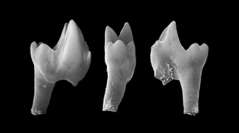

 Comptes Rendus Palevol
9 (1-2) - Pages 63-71
Comptes Rendus Palevol
9 (1-2) - Pages 63-71The Late Cretaceous record of mammals from India assumes great significance in view of the fact that it is the only Gondwanan landmass that has yielded definitive eutherian mammals. These mammals have variously been assigned to palaeoryctids, archontans or Eutheria incertae sedis. Well preserved lower molars recovered from a new mammal-yielding Deccan intertrappean site near Kisalpuri village, Dindori District, Madhya Pradesh (state), India, are described here under a new species Deccanolestes narmadensis sp. nov. The new fossil material indicates close phylogenetic relationship between Deccanolestes from India and Afrodon (Adapisoriculidae) from the Late Palaeocene of Africa and Europe. In view of older age and more primitive state of Deccanolestes teeth, it is inferred that Deccanolestes represents an ancestral morphotype from which the African/European adapisoriculid Afrodon may have been derived. This is the first compelling terrestrial fossil evidence for an early dispersal between India and Africa. Such a dispersal possibly involved an East African contact with India at the KT transition.
Cretaceous, Mammals, Deccanolestes, Afrodon, Adapisoriculids, Dispersal, India, Africa